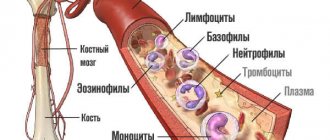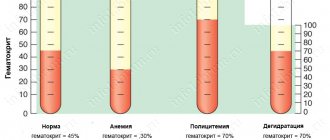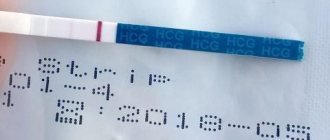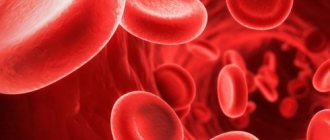A complete blood count is a simple, routine method for assessing health status, including rheological and other properties of fluid connective tissue.
The method is used to roughly estimate the state of things. It does not provide accurate data, therefore it is impossible to consider this path as the basis for a full-fledged diagnosis. Perhaps as an additional event to clarify the situation.
As part of the CBC (complete blood count), the following is studied:
- Platelet level.
- Leukocyte counts.
- Concentration of erythrocytes (red blood cells).
- ESR is also the erythrocyte sedimentation rate, a level that indicates inflammatory, infectious, and autoimmune processes. True, it is non-specific. That is, it does not say what the origin of the pathological condition is in this particular case. Additional diagnostics are required.
The erythrocyte sedimentation rate is studied as part of a general analysis and is also interpreted in a system with other points.
For example, obvious inflammation is indicated by the growth of leukocytes and at the same time ESR, and it can almost always be argued that the pathology is infectious in nature.
A trained eye allows you to draw some conclusions right off the bat.
General information
New methods for diagnosing and determining the causes of diseases appear in modern medicine regularly. However, determining ESR in human blood is still an effective diagnostic method.
It is used for diagnostic purposes in both children and adults. Such a study is prescribed both when a patient who is concerned about a certain disease contacts a doctor, and during preventive examinations. Any doctor can interpret this test. ESR is included in the group of general blood tests (CBC).
If this indicator is elevated, you need to determine the cause of this phenomenon.
How to prepare
The duration of the analysis does not exceed 5-10 minutes. As a rule, the procedure is accompanied by slight pain and discomfort in the puncture area, but the discomfort passes very quickly. If capillary blood is needed, then before piercing the third or fourth finger of the left hand, the skin in this place is treated with an alcohol cotton ball. After this, using a special medical blade, a small incision is made on the fingertip (its depth does not exceed 3 millimeters). The resulting drop of blood is disposed of with a sterile napkin, after which the laboratory assistant proceeds to collect the biomaterial. Having collected the required amount, the wound surface is lubricated with an antiseptic, and a cotton swab with alcohol is applied to the puncture site.
If the analysis involves taking biomaterial from a vein, then the patient’s forearm is tightened with a medical tourniquet or strap, after which he must work a little with his fist (clench and unclench) for better vascular filling. The site of the intended puncture is treated with an alcohol wipe, after which a needle is inserted into the selected vessel, to which a test tube is connected to collect the released blood. Having collected a sufficient amount of biomaterial, the needle is removed, and a cotton swab with alcohol is applied to the wound.
To calculate ESR, an anticoagulant is placed in the biological material to prevent clotting. Then it is sent to a vertical container for 60 minutes. Since the specific gravity of red blood cells exceeds the weight of plasma, gravity forces them down to the bottom of the container. Because of this, 2 visible layers are formed in the test tube: the upper (colorless plasma) and the lower (erythrocyte accumulations). Then the laboratory assistant takes measurements of the top layer. The indicator corresponding to the mark between the red blood cells and the plasma zone on the test tube scale is ESR (indicated in mm/h).
Today there are 2 main ways to detect ESR:
- Panchenkov's method. The capillary is divided into exactly one hundred compartments, and later 5% sodium citrate is added to it to the “P” level. Then the capillary is filled with biomaterial up to the letter “K”. The resulting mixture is mixed and installed vertically. The assessment takes place after 60 minutes.
- Westergren method. Here, venous blood is used, mixed with sodium citrate 3.8% in a ratio of 4:1. It can be mixed with Trilot B followed by the addition of sodium citrate or saline solution in an amount of 4:1. The study is carried out in test tubes equipped with a 200 mm scale. The result is assessed after 60 minutes. This technique is used everywhere, and its main distinguishing feature is the type of test tubes and measuring scale used.
Despite the coincidence of the results of these methods, the Westergren method is famous for its greater sensitivity to exceeding the ESR indicator, and therefore it is considered highly accurate and informative.
What is ESR in the blood?
Those who are prescribed such a study are interested in why an ESR analysis is performed and what it is. So, the abbreviation ESR is the capital letters of the term “ erythrocyte sedimentation rate ”. Thus, using this test, the erythrocyte in the blood can be accurately determined.
Erythrocytes are, as you know, red blood cells. anticoagulants act on them over a certain period, they settle at the bottom of the capillary or test tube. The time during which a blood sample taken from a patient is divided into upper and lower layers is defined as ESR. It is assessed by the height plasma layer , which was obtained during the research process, in millimeters per 1 hour. The ESR indicator is nonspecific, however, it has high sensitivity.
If the ESR level in the blood is elevated, this may indicate the development of various disorders in the body. So, sometimes this is an indicator of the development of infectious, oncological, rheumatological and other pathologies even before the manifestation of obvious symptoms of diseases. Accordingly, if the ESR level is normal, the doctor, if necessary, prescribes other tests.
The ESR norm for women is 3 to 15 mm/h. But you need to take into account that this indicator also depends on age - normally it can be different for women under 30 and after 30 years. If necessary, the norm of red blood cells in the blood of women is also determined. In pregnant women, ESR increases starting from the fourth month. It should be taken into account that the ESR rate in pregnant women may vary depending on the period of gestation.
The norm for ESR in men is from 2 to 10 mm/h. A general blood test also determines red blood cells in the blood of men.
The normal ESR level in the blood of children depends on the age of the patient.
This value in the diagnostic process is important for:
- differentiation of diagnosis ( appendicitis and ectopic pregnancy , angina pectoris and myocardial infarction , rheumatoid arthritis and osteoarthritis , etc.);
- determining the body's response during the treatment of patients with tuberculosis , lymphogranulomatosis , rheumatoid arthritis , etc.;
- determining a disease that occurs latently (but it should be borne in mind that even normal ESR values do not exclude the development of a disease or neoplasm in the body).
Sometimes this concept is referred to as ROE . ROE in the blood and ESR are identical concepts. Speaking about ROE in the blood, we understand that this is an erythrocyte sedimentation reaction .
Once upon a time, this very concept was used in medicine, that is, the norm of ROE in the blood for women, the norm of ROE in the blood of children, etc. were determined. Currently, this concept is considered outdated, but any doctor understands what ROE is in a blood test, what ROE is in oncology, etc.
Editorial opinion
The ESR indicator depends not only on physiological processes in the human body, but also on the psychological component. Both negative and positive emotions influence ESR indicators. Severe stress or a nervous breakdown will certainly change the erythrocyte sedimentation reaction. Therefore, on the day of blood donation and the day before it, it is advisable to normalize your psycho-emotional state.
Author of the article:
Alekseeva Maria Yurievna |
Therapist Education: From 2010 to 2021 practicing physician at the therapeutic hospital of the central medical unit No. 21, the city of Elektrostal. Since 2021 he has been working at diagnostic center No. 3. Our authors
Diseases in which there is an increased ESR in the blood
If a patient has an elevated ESR in the blood, what this means is determined by the doctor during the diagnostic process. After all, this indicator is very important for diagnosis if the development of a certain disease is suspected. In the diagnostic process, a qualified doctor takes into account not only the fact that the patient has an increased value, but also determines what the presence of other symptoms indicates. But still this indicator is very important in many cases.
ESR: increased in diseases
An increased ESR in the blood of a child and an adult is observed if a bacterial infection - during the acute phase of a bacterial infection.
In this case, it does not matter where exactly the infections are localized: the picture of the peripheral blood will still reflect the inflammatory reaction.
viral infectious diseases occur . What specifically causes this indicator to increase is determined by the doctor during a comprehensive examination.
Thus, we are talking about the development of a certain pathological process if the ESR is higher than normal. What this means depends on the value of the indicator. Very high values – more than 100 mm/h – occur with the development of infectious diseases:
- for sinusitis , bronchitis , pneumonia , ARVI , colds , tuberculosis , influenza , etc.;
- for cystitis , pyelonephritis and other urinary tract infections ;
- for fungal infections , viral hepatitis ;
- in oncology (high rates can be observed for a long time).
During the development of an infectious disease, this value does not increase quickly; an increase is observed after 1-2 days. If the patient has recovered, the ESR will be slightly elevated for several more weeks or months. The reasons for a high ESR with normal leukocytes may indicate that the person has recently suffered a viral disease: that is, the leukocyte count has already returned to normal, but the red cell sedimentation rate has not yet.
The reasons for increased ESR in the blood in women may be associated with pregnancy, therefore, in the diagnostic process, the doctor must take into account these reasons for the increase in ESR in the blood in women.
An increase in ESR is a typical symptom in the following diseases:
- diseases of the biliary tract and liver;
- inflammatory diseases of a purulent and septic nature ( reactive arthritis , etc.);
- blood diseases ( sickle anemia , hemoglobinopathies , anisocytosis );
- ailments in which tissue destruction and necrosis ( stroke , heart attack , tuberculosis , malignant neoplasms);
- pathologies of the endocrine glands and metabolic disorders ( obesity , diabetes , cystic fibrosis , etc.);
- malignant degeneration of the bone marrow, in which red blood cells enter the blood that are not ready to perform direct functions ( myeloma , leukemia , lymphoma );
- autoimmune diseases ( scleroderma , lupus erythematosus , rheumatism , etc.);
- acute conditions in which the blood becomes more viscous ( diarrhea , bleeding , vomiting , postoperative conditions , etc.).
What does erythrocyte sedimentation rate show?
The ESR level clearly demonstrates various types of inflammatory processes. To understand why this happens, a very superficial look at human physiology is enough.
Red cells do not exist in a vacuum. They are constantly exposed to components of the liquid fraction of blood, including albumin proteins.
If the cell structure is normal, they maintain the same density for a long time. Otherwise, it changes. That is, either the red blood cells become heavier, then they settle faster, or they become lighter - the opposite phenomenon occurs. In the inflammatory process, the first option prevails.
Based on such patterns, observations and empirical materials, doctors came to understand the role of the indicator.
Specific diseases cannot be identified through a general blood test. But some suspicions still arise.
Violation of ESR leads to thoughts about:
- Infections.
- Inflammatory processes of an autoimmune nature.
- Allergic reactions. Much less often.
- Helminthic infestations.
- Cancerous tumors.
- Hormonal imbalances.
- Necrosis of tissues of any localization.
- Pathologies of the excretory system.
Next, you need to conduct specific examinations. By profile.
A blood test for ESR shows probable diseases of liquid tissue, kidneys, autoimmune and infectious inflammation, disruption of endocrine structures, and indirectly gives suspicion of cancer processes.
Normal and pathological ESR values
In medicine, the physiological limits of this indicator are determined, which are the norm for certain groups of people. Normal and maximum values are shown in the table:
| In children (value depends on the age of the child) | Among women | In men |
|
|
|
ESR during pregnancy
If this value is increased during pregnancy , this is considered a normal condition.
The normal ESR rate during pregnancy is up to 45 mm/h. With such values, the expectant mother does not need to be further examined and the development of pathology is not suspected.
False increase in ESR
An increase in indicators can occur in the absence of any pathology. A false increase in values is detected in the following cases:
- Taking medications that contain hormones;
- An increased ESR may be a variant of the norm, because all people are individual. Thus, 3–5% of the Earth’s population has an increase in indicators, which is a physiological feature of the body;
- In women in the 2nd half of pregnancy, there is a significant increase in indicators;
- The presence of allergies can cause a faster reaction;
- Iron deficiency in the body, which causes anemia (iron deficiency and B12 deficiency anemia);
- A large amount of vitamin A enters the body, this occurs with the uncontrolled use of vitamin complexes;
- In children 4–12 years old, a false increase in ESR may be observed, the reason is the rapid growth and development of the child’s body;
- Improper and inadequate nutrition;
- Excess body weight (3rd and 4th degree of obesity).
Methods used to test ESR blood
Before deciphering what ESR means in a blood test, the doctor uses a certain method to determine this indicator. It should be noted that the results of different methods differ and are not comparable.
Before performing an ESR blood test, it must be taken into account that the obtained value depends on several factors. The general analysis must be carried out by a specialist - a laboratory employee, and only high-quality reagents are used. The analysis in children, women and men is carried out provided that the patient has not eaten food for at least 4 hours before the procedure.
What does the ESR value show in the analysis? First of all, the presence and intensity of inflammation in the body. Therefore, if there are abnormalities, patients are often prescribed a biochemical analysis. Indeed, for high-quality diagnostics it is often necessary to find out in what quantity a certain protein is present in the body.
ESR according to Westergren: what is it?
The described method for determining ESR - the Westergren method - currently meets the requirements of the International Committee for Standardization of Blood Studies. This technique is widely used in modern diagnostics. For such an analysis, venous blood is needed, which is mixed with sodium citrate . To measure ESR, the distance of the stand is measured, the measurement is taken from the upper limit of the plasma to the upper limit of the red blood cells that have settled. The measurement is carried out 1 hour after the components have been mixed.
It should be noted that if Westergren's ESR is elevated, this means that this result is more indicative for diagnosis, especially if the reaction is accelerated.
ESR according to Wintrob
The essence of the Wintrobe method is the study of undiluted blood that was mixed with an anticoagulant. The desired indicator can be interpreted using the scale of the tube in which the blood is located. However, this method has a significant drawback: if the reading is above 60 mm/h, the results may be unreliable due to the fact that the tube is clogged with settled red blood cells.
ESR according to Panchenkov
This method involves the study of capillary blood, which is diluted with sodium citrate - 4:1. Next, the blood is placed in a special capillary with 100 divisions for 1 hour. It should be noted that when using the Westergren and Panchenkov methods, the same results are obtained, but if the speed is increased, then the Westergren method shows higher values. Comparison of indicators is in the table below.
| According to Panchenkov (mm/h) | Westergren (mm/h) |
| 15 | 14 |
| 16 | 15 |
| 20 | 18 |
| 22 | 20 |
| 30 | 26 |
| 36 | 30 |
| 40 | 33 |
| 49 | 40 |
Currently, special automatic counters are also actively used to determine this indicator. To do this, the laboratory assistant no longer needs to dilute the blood manually and track the numbers.
How the research is carried out
The accuracy of this diagnostic method depends on many nuances: proper preparation for the test, the professionalism of the laboratory worker and the quality of the reagents. Subject to these conditions, you can guarantee the most reliable result. And if the person donating blood cannot influence the last 2 points, then the preparatory stage completely depends on him. Despite the fact that in this case no special and complex preparation is required, there are a number of mandatory general rules that are strongly recommended to be followed.
First of all, 1 day before the test, you must stop drinking alcoholic beverages, and also refrain from eating for 4-5 hours. Only drinking plain water is allowed. It is also recommended to quit smoking an hour before the test. Secondly, if the patient takes (on an ongoing basis or only at the moment) any medications, then the doctor must be informed about this in advance. Some medications can distort the results, which is why their use may be stopped and reinstated after donating blood. Thirdly, on the eve of the procedure you should not visit sports or gyms. You should also refrain from intense physical activity and avoid emotional stress.
If you doubt anything, just call us at this number +375(29) 666-30-96 or make an appointment with a doctor using our online form.
ESR in the blood: what do certain values mean?
As mentioned above, normal ESR values for a healthy man are considered to be 1, 2, 3, 4, 5, 6, 7, 8, 9, 10 mm per hour; for women, the normal value is from 2 to 15 mm/hour. Therefore, for women, a value of 12, 13, 14, 15 is considered normal. However, indicators for women in adulthood can normally be 16, 17, 18, 19, 20.
If the value exceeds the norm by several units, then the blood condition can be considered relatively normal. That is, an indicator of 21, 22 in a woman can be considered acceptable, as well as values of 23, 24 mm/h. When a woman is pregnant, this meaning is even greater. Therefore, expectant mothers have no reason to believe that a reading of 25 means something unpleasant. During pregnancy, the analysis may show 28, 29. ESR 30, 31, 32, 33, 34, 35, 36, 38 is also not evidence of the development of pathological processes in pregnant women.
This indicator increases with age. Therefore, if an ESR value of 40 is noted in elderly patients, the doctor determines what disease this is a symptom of and what it means by the accompanying signs. Normal values for older people are 43, 50, 52, 55 mm/h, etc. However, for young people, values of 40-60 mm/h are possibly evidence of serious disorders. Therefore, after receiving the analysis data, it is necessary to consult in detail about why the ESR is 60, what it could be, and undergo further research.
Low value
As a rule, the reasons for a low value of this indicator are associated with exhaustion of the body, weight loss, taking corticosteroids, hyperhydration, and muscle atrophy. Sometimes ESR is lowered in diseases of the heart and blood vessels.
Reasons for the growth of the indicator
An increased erythrocyte sedimentation rate is the result of infections, excessive immune activity, necrosis, cancer, and hormonal imbalances.
If we talk about factors increasing the level, they can be like this:
- Diabetes. A chronic disease in which insulin production decreases or tissues become insufficiently sensitive to it. The result is surges in blood sugar, vascular disorders, tissue ischemia, gangrene, blindness. Lots of complications. Even fatal. Urgent help from an endocrinologist is needed.
- Excessive production of thyroid hormones. T3 and T4. The condition is called hyperthyroidism. Accompanied by a lot of discomfort: headaches, weakness, weight loss, fever, instability of blood pressure.
The body literally destroys itself, burning all reserves at an accelerated pace. Treatment with iodine preparations is necessary to reduce the activity of the organ.
- Infections. Any origin. Whether bacterial, viral or fungal processes, ESR is always higher than normal. Treatment is carried out by therapists, ENT doctors and others according to their profile. Drugs are prescribed to kill pathogens.
- Autoimmune disorders. Inflammatory conditions that are provoked by one’s own defenses. Objectively, there are no reasons for a violation. The body, roughly speaking, comes up with them itself.
The provocateur can be anything: an allergen, a previous infection. The body is in a state of over-alert and responds to a harmless trigger. Treatment is provided by rheumatologists and immunologists.
- Parasitic infestations. Worms. Not necessarily in the intestines. There are many varieties of uninvited guests: some affect the liver, others are localized in almost any system where they enter through the bloodstream. Treatment is urgent because the condition is serious.
- Tissue necrosis. Dieback. For example, against the background of gangrene or heart attack, stroke. Cell breakdown products must be disposed of. Therefore, leukocyte counts and ESR levels increase as a temporary phenomenon.
- Allergic reactions, which have already been mentioned.
- Cancer processes. Especially at advanced stages, when active decay of cells of altered structure begins. They poison the body because they turn into poisons. Requires disposal. The scavengers are white blood cells. ESR increases gradually, but almost never decreases. The root cause needs to be treated.
- Kidney diseases. From inflammatory phenomena to nephropathy, organic disorders. Doesn't really matter. Treatment of the underlying pathological process is carried out. Urologists and nephrologists are involved in solving this problem.
- Malignant bone marrow disorders. When too many formed elements are produced.
Accelerated ESR syndrome is most often caused by infectious inflammation, allergic reactions and autoimmune processes.
At the same time, the degree of increase can be used to judge the complexity of the pathology. For example, growth up to 100 mm per hour and higher is typical for severe disorders: tuberculosis, hepatitis, bladder damage, influenza, pneumonia, cancer. That is, acute phenomena.
What affects the ESR indicator?
In both women and men, the level of ESR is influenced by a number of different factors, both physiological and pathological. The key factors that most influence this analysis are identified:
- When determined by different methods - according to Westergren et al. - the norm of ESR in the blood of women is higher than that of men. So, an ESR of 25 in a woman may be normal. This is due to the physiological characteristics of blood in women.
- What is the normal ESR level in a woman’s blood depends on whether she is pregnant. For expectant mothers, the norm is from 20 to 45 mm/h.
- A higher ESR is observed in women who take contraceptives . Under this condition, a woman may have a normal ESR of 30. What this means, whether there is a pathology, or whether we are talking about a normal physiological indicator, must be determined by the doctor.
- In the morning, the rate at which red cells settle is higher than in the afternoon and evening, and differences in age do not matter here.
- Signs of accelerated sedimentation are observed when exposed to acute phase proteins.
- If inflammation and an infectious process develops, the values change a day later. how leukocytosis and hyperthermia . That is, on the first day of the disease the indicator can be 10, 14, 15 mm/h, and a day later it can increase to 17, 18, 20, 27, etc.
- ESR is elevated if there is a chronic source of inflammation in the body.
- A reduced value is observed with increased blood viscosity .
- A decrease in sedimentation rate occurs under the influence of anisocytes and spherocytes; the rate becomes greater under the influence of macrocytes.
Proper preparation for the test
As for specific recommendations:
- Biomaterial is given on an empty stomach. It's best in the morning, while your metabolism is still slow. That is, approximately until 9-10.00 local time. Taking into account your own biorhythms.
- You should also not overeat in the evening. This will lead to distortion of the survey results.
- In a few days you need to give up oral contraceptives and vitamin preparations. This is the only exception when preparation begins earlier.
- You need to tell your doctor about your cycle or early pregnancy. When the situation is not yet clear.
- It is important to stick to your diet. Don't overeat, as said, but don't starve either. Otherwise, the results will again be false.
In general, the analysis is not particularly difficult. Minimal and very simple preparation on the eve of the diagnostic event is sufficient.
Otherwise, you will have to donate blood again. Or the doctor will inadvertently prescribe completely useless and even harmful treatment.
Elevated ESR in children
When the ESR norm in children is exceeded, most likely an infectious inflammatory process develops in the body. But it should be taken into account, when determining ESR according to Panchenkov, that other indicators of the CBC ( hemoglobin , etc.) are also increased (or changed) in children. Also, in children with infectious diseases, their general condition worsens significantly. In case of infectious diseases, the ESR is high in the child already on the second or third day. The indicator can be 15, 25, 30 mm/h.
If red blood cells are elevated in a child’s blood, the reasons for this condition may be the following:
- metabolic disorders ( diabetes , hypothyroidism , hyperthyroidism );
- systemic or autoimmune diseases ( bronchial asthma , rheumatoid arthritis , lupus );
- blood diseases , hemoblastosis , anemia ;
- diseases in which tissue decay occurs ( tuberculosis , myocardial infarction , cancer ).
It is necessary to take into account: if even after recovery the erythrocyte sedimentation rate is increased, this means that the process is proceeding normally. It’s just that normalization is slow, but after about one month after the disease, normal levels should be restored. But if there are doubts about recovery, then you need to do a re-examination.
Parents must understand that if a child’s red blood cells are higher than normal, this means that a pathological process is taking place in the body.
But sometimes, if a baby’s red blood cells are slightly elevated, this means that some relatively “harmless” factors are influencing:
- in infants, a slight increase in ESR may be associated with a violation of the mother's diet during natural feeding ;
- period of teething;
- after taking medications ( Paracetamol );
- with a lack of vitamins ;
- with helminthiasis .
Thus, if red blood cells are elevated in the blood, this means that the child is developing a certain disease. There are also statistics on the frequency of increase in this value in various diseases:
- in 40% of cases, a high value indicates infectious diseases ( respiratory tract diseases , tuberculosis , urinary tract diseases , viral hepatitis , fungal diseases );
- in 23% - oncological processes of various organs;
- in 17% - rheumatism , systemic lupus ;
- in 8% - cholelithiasis , inflammation of the gastrointestinal tract , pelvic organs , anemia, ENT diseases , injuries , diabetes , pregnancy ;
- 3% — kidney disease.
When is a test ordered?
The study is applied to a wide group of clinical cases. This is the basis of diagnosis, although not the key technique.
Specific indications include:
- Increased body temperature. Most likely, the reason is precisely the inflammatory process. Autoimmune or infectious origin. Which one exactly needs to be looked at separately. A general blood test will not get rid of it.
- Symptoms of intoxication. Headaches, severe weakness, drowsiness, feeling of exhaustion. This also includes nausea, vomiting, episodes of body weakness, and constant fatigue.
Everything that indirectly indicates infection, poisoning of the body with waste products of bacteria, decay of one’s own cells that die as a result of the influence of a foreign structure. Analysis will shed light on the situation.
- Focal infectious disorders and suspicions of such. Absolutely any character. For example, damage to the throat, oropharynx, lungs, respiratory tract, genitals, and excretory system. There are hundreds of options. Potentially any localization.
The goal is simply to confirm the increase in ESR levels. This is a sufficient basis for further diagnosis and in-depth research.
- Clear signs of autoimmune disorders. For example, inflammation of the joints, changes in skin tone and temperature in local areas, and so on. Everything that indicates a pathological process.
- Preparing for surgery. To exclude inflammation before radical treatment. Since any deviations of this kind are a contraindication for correction. We'll have to wait until the situation normalizes. Only then can intervention be carried out.
- Time after surgical treatment. As part of the assessment of the period after surgery. Blood is taken first every 3-5 hours, then less and less often. This is important, in patients with a weakened immune system, or if a medical error was made, acute inflammation may develop, including sepsis. This is a possible complication of the pathological condition.
- Suspicions of cancer. Cancer also leads to an increase in ESR, even at the earliest stages. The absence of symptoms and a clear abnormality in laboratory results, such a discrepancy should give rise to concern.
Suspicions can be confirmed or refuted only through MRI and histological techniques. Depends on the location and specific type of tumor.
Attention:
Benign neoplasias do not produce inflammatory processes; they cannot be detected that way.
- Pain of unknown origin. Any localization.
- Scheduled examination. A complete blood test with erythrocyte sedimentation rate is an effective way to check your health. Conducted every six months. Maybe a little less.
- Evaluation of the effectiveness of therapy. Dynamics of the main pathological process.
Here are the main points. In fact, a general blood test (which includes the CBC) is used in all cases without exception, as an attempt to establish a vector for further diagnosis.
ESR (ROE) is a universal indicator that indicates in favor of inflammatory-infectious, autoimmune and even cancer processes.
This analysis alone, of course, is not enough to give an accurate answer to what’s what. Advanced diagnostics required. The methods are selected by the attending physician, based on complaints, anamnesis and laboratory findings.
When can increasing ESR be considered safe?
As you know, an increase in red blood cells in the blood, as a rule, indicates that a certain inflammatory reaction is developing in the body. But sometimes the reasons for the increase in red blood cells in the blood of women and men are not so categorical.
We are talking, first of all, about allergies , when analysis in men and women helps to judge whether anti-allergy treatment is being carried out correctly (fluctuations in the initially elevated ESR should be taken into account). That is, if the clinical effect of the drug occurs, then gradually the normal ESR level in the blood of men, as well as in women, will be restored.
A hearty breakfast before the test can also increase this indicator; a strict diet and fasting can also change it.
ROE can change during menstruation, during pregnancy and after the birth of a child.
Reasons for decreased ESR
A reduced value of this indicator may be the result of pathology or an individual physical characteristic of the body.
Pathological reasons for decreased performance:
- Decreased hemoglobin levels (sickle cell anemia);
- Epilepsy;
- Neurotic conditions;
- Violation of water-salt balance in the body;
- Uncontrolled use of hormonal drugs (glucocorticosteroids);
- Congenital pathology of the cardiovascular system;
- Thermal burns with a large area of damage;
- Myodystrophy is the progression of atrophic changes in muscle tissue.
The following reasons cannot be attributed to pathology, although even with them a decrease in ESR is observed:
- The first half of pregnancy (a physiological condition that does not require correction);
- Strict diets aimed at weight loss;
- Starvation.
A decrease in indicators can also be observed when a person refuses animal food (vegetarians).
False-positive ESR tests
In medicine there is also the concept of a false positive analysis. An analysis of ESR is considered such if there are factors on which this value depends:
- anemia (no morphological changes in red blood cells occur);
- increase in the concentration of plasma proteins , with the exception of fibrinogen ;
- hypercholesterolemia;
- renal failure;
- obesity ;
- pregnancy;
- old age of a person;
- administration of dextran ;
- a technically incorrect study;
- taking vitamin A ;
- recent vaccination against hepatitis B.
What to do if the reasons for the increase are not determined?
If the analysis is normal, but the causes of the increased erythrocyte sedimentation rate cannot be determined, it is important to conduct a detailed diagnosis. It is necessary to exclude oncological diseases , so lymphocytes , GRA, and the norm of leukocytes in women and men are determined. During the analysis process, other indicators are also taken into account - whether the average volume of erythrocytes is increased (what this means - the doctor will explain) or whether the average volume of erythrocytes is decreased (what this means is also determined by the specialist). Urine tests and many other studies are also carried out.
But there are cases when high ESR levels are a feature of the body, and they cannot be reduced. In this case, experts advise regular medical examinations, and if a certain symptom or syndrome appears, consult a doctor.
Mechanism of development of the disorder
The development of the pathological process is based on approximately the same pathogenetic pattern.
Red blood cells have a certain density. The norm was derived empirically, based on many years of research with hundreds of millions of people.
Some measure has been developed. In various pathological processes, the density of formed cells compared to the level of plasma, the liquid fraction, increases or decreases (depending on the specific condition).
The higher it is, the higher the erythrocyte sedimentation rate and vice versa.
As for more specific mechanisms, there may be several options:
- Inflammatory processes. Infectious or autoimmune. The problem is a change in the structure of formed cells. They begin to stick together, forming large conglomerates.
Such complex formations settle to the bottom of the test tube faster when examined using standard methods, and accordingly, the ESR increases.
- Allergies. A variant of an autoimmune pathological process. Accompanied by a change in the nature of the work of the whole organism. Defense forces react to innocuous structures.
The reason is hypersensitization, excessive sensitivity. We need to solve the problem in advance. In order not to provoke changes in the concentration of red blood cells and ESR.
- Kidney pathologies. Diseases of an inflammatory nature and any other. Anatomical deviations. They provoke intoxication of the whole body.
- Oncological phenomena, cancer. Malignant processes cause changes in the structure of all formed cells and lead to an imbalance in the body.
Recovery is carried out under the supervision of an oncologist. As soon as the problem is solved, the ESR indicators will normalize by themselves.
- Endocrine disorders. Hormonal imbalances. An increase in ESR occurs due to pathologies of the thyroid gland, pancreas or adrenal glands. There are many options, at a minimum an ultrasound is required.
There are also natural factors. They are not considered pathological, however, they provoke false changes in laboratory tests. It is necessary to carefully understand the situation.
How to reduce ESR in the blood?
The doctor will tell you in detail about ways to reduce this indicator with the help of medications after the study. He will prescribe a treatment regimen once the diagnosis has been made. It is strictly not recommended to take medications on your own. You can try to reduce it with folk remedies, which are mainly aimed at restoring normal function of the immune system , as well as cleansing the blood. Effective folk remedies can be considered herbal decoctions, teas with raspberries and lemon, beet juice, etc. How many times a day to take these remedies, how much you need to drink, you should find out from a specialist.
Additional examinations
Diagnosis is carried out under the supervision of a specialized doctor. At the initial stage, when nothing is known, the patient most often falls into the hands of a therapist.
Sample list of procedures:
- Oral survey.
- Anamnesis collection.
- Serological tests, bacteriological cultures, PCR, ELISA. Everything that will allow you to detect an infection.
- Blood chemistry.
- Ultrasound of the abdominal organs, kidneys.
- Scintigraphy of the excretory system.
- MRI if cancer is suspected. Observational and with the use of a contrast agent.
- Bone marrow puncture. Rarely.
- Hormone tests.
A high ESR is not a very informative indicator. Although it does give some thought. A full diagnosis is needed.











